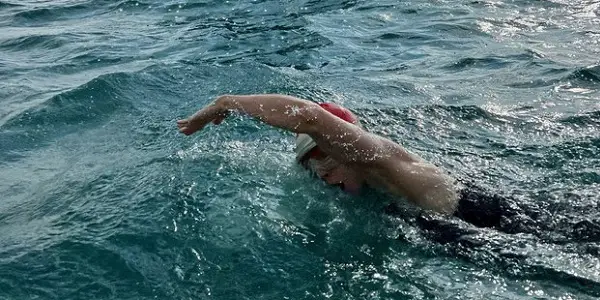
The true story of Trudy, the first woman to swim the English Channel, is inspiring. The trail it blazed has led someone to remark, “Hey, that could make a great movie.” Young Woman and the Sea proves it could be a serviceable movie but not strong enough to escape the routine assembly of the genre’s trappings.
A Rebellious Swimmer
The film stresses its melodrama early to set the mood. The young Trudy is feared to die from her illness but recovers in a heartfelt moment of surprise. If she bounces back from that experience, she will surely achieve more miracles when she grows older, as portrayed by Daisy Ridley. Trudy and her sister, Meg (Tilda Cobham-Hervey), are interested in swimming. It’s a development that pleases their stern mother, Gertrude (Jeanette Hain), fearing their lack of swimming knowledge could lead to their drowning deaths.
source: Disney
An era of sexism and taboo leads to Trudy and Meg receiving swimming lessons in secret. Once more, Trudy rises above the fray, going from the underdog of the class to the top swimmer. As the sisters become skilled swimmers, they compete in women’s swimming events. With Trudy’s ascension in the sport, she may become the first woman to complete swimming the English channel. Her luck’s been good so far, even if she falters at the Olympics.
A Speedy Pace
Director Joachim Rønning continuously spins the drama to highlight the moments that matter. Ridley’s performance is at its strongest when connecting with Cobham-Hervey and Hain. Those moments are great, but they’re over before they flourish as little more than obligatory emotions before the next big swim. Which, to the film’s credit, boasts some enticing depictions of the sport. Plenty of stunning shots above, below, and between the waves as Trudy completes laps.
But the speed of the film also gives it the unfortunate aspect of feeling less like a story and more like a series of bullet points. As the film races from swim to swim, so much of the drama feels surface-level regarding how briefly it is addressed. A crucial moment in the film comes when Meg decides to concede to societal norms and marry reluctantly instead of continuing her swimming. There should be some sting, but so little time is spent with Meg’s concerns that her marriage arrives almost inexplicably. How I wished there was a chance to spend more time with these characters so that Trudy’s confrontation with Meg over this marriage stung more as compelling drama rather than melodrama.
source: Disney
I’m torn with this type of direction. The swimming scenes, especially Trudy’s big swim through the English Channel, are exciting and fun to watch. But it runs the risk of the direction, making many family moments and discussions feel more like melodramatic filler than a progressive story. The gears are visible as Trudy treads closer to her goal of becoming a legend in the history of women swimmers. This becomes especially vocal with the eccentric companion of Stephen Graham as Bill Burgess and the rival sabotager of Christopher Eccleston as Jabez Wolffe. These characters become restricted to their roles, as with Graham offering great cheers and a frustrated Eccleston chucking a radio out of a window when Trudy succeeds in her historical swim.
Better Laps in a Shallow Pool
The film feels more essential for its historical relevancy than the greater appeal of this type of genre. Criticizing the film for feeling like a bog-standard milestone sports movie is easy. It proceeds down a familiar path of heightening the experience of Trudy’s swim while simplifying everything else around the swimming. When in the water, there are dynamic shots and genuine tension. When out of the water, there’s drama so brisk and fundamental that there’s an earnest desire to return to swimming as quickly as possible. It’s easy to feel anxious as the by-the-numbers biopic moments are so dry that it makes one thirsty for more of those fast-paced laps and treks.
source: Disney
The film finds some firmer footing by the time it gets to the third act, and the long swim through the English Channel is on. Rønning’s direction shines brightest here. From a swarm of stinging jellyfish to the rolling fog that makes it challenging to determine directions, there’s a drive that makes the exaggerated nail-biting come more naturally. As Trudy nears the finish line of the shore, it’s hard not to feel some enthusiasm for her to finish this one-woman race and prove everybody wrong finally. She gains her cheer, and the film treats us to the true story epilogue about her influence.
Conclusion: Young Woman and the Sea
Young Woman and the Sea swims decently enough through familiar waters to present a steady, sturdy, and safe sports drama. It’s a story that deserves to be told, and it’s sure to please the fact-scarfing historians who want something entertaining to put on rather than spout a checklist of Trudy’s accomplishments and struggles. The film outlines this in a way that is directed with enough jolts of stirring to keep the kids interested. There’s equality present not just in Trudy’s story but in her film presentation. She can swim just as well as any expert swimmer and receive as much of a passable and ho-hum movie adaptation as any sports figure. It’s worth watching more for what it represents than what happens when Trudy’s not facing the perils of her most dangerous swim.
Young Woman and the Sea is currently streaming on Disney+.
https://youtu.be/7tNvrYzPUrk?si=5EPLCgJ8DEvudcCb
Does content like this matter to you?
Become a Member and support film journalism. Unlock access to all of Film Inquiry`s great articles. Join a community of like-minded readers who are passionate about cinema – get access to our private members Network, give back to independent filmmakers, and more.





